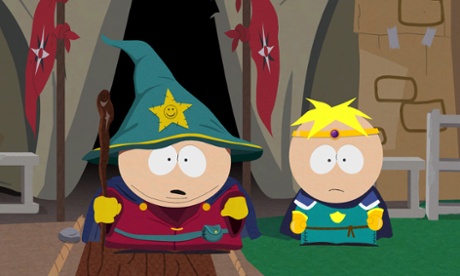
It’s tough being the new kid. Within a few minutes of arriving in South Park my wee avatar had earned the indelible nickname “douchebag”, bestowed upon him by the local chubby bully, and been beaten up by a bunch of kids dressed as elves.
Far, far worse was to come. South Park: The Stick of Truth is exactly as foul and exactly as funny as I thought it might be - but it actually plays better than I dared hope. It’s a proper open-world role-playing game set in the South Park universe, casting you as a stranger in a town that’s instantly familiar.
Like the show, South Park: The Stick of Truth’s humour is heavy on bodily excretions and things that look like balls, but there are frequent flashes of satirical cleverness among the prevalent boyish, gross-out comedy.
Everything about Stick of Truth is exactly like the show. It’s perfectly pitched. The close involvement of South Park’s creators, Matt Stone and Trey Parker, is evident in the tiniest details, like the contents of South Park residents’ bedroom closets - they’re all stuffed with props and memorabilia from South Park’s vast pool of episodes.
Within minutes, my inventory was full of paraphernalia such as cherokee hair tampons, Chinpokomon and a set of wearable chinballs. Much of it is in terrible taste, but what else would you expect?
Cartman rules
What surprised me is how well this South Park skin fits a tactical RPG. It has classes, leveling, turn-based combat and stats galore on pretty menu screens, but all within this well-known, foul-mouthed cartoon world populated by what seems to be hundreds of characters from the iconic to the totally obscure.
All the voices are right, the writing is sharp, the look is spot-on. This is about as far away as you can get from the travesty that was the latest Family Guy video game, with its ripped dialogue samples and dreadful cobbled-together scenarios.
(But then of course, Stick of Truth is the work of respected RPG veteran Obsidian Entertainment, previously known for Neverwinter Nights 2 and Fallout: New Vegas. This studio knows how to take an established series and make it work.)
Stick of Truth’s premise is really about kids being kids. You’re immediately drawn into a neighbourhood rivalry between Cartman’s gang of nine-year-old warriors and boys from the other side of town, fighting over a branch called the Stick of Truth in an imaginary high-fantasy narrative.
The kids are dressed up in adorably lame costumes - wizards, warriors, blacksmiths - in Cartman’s back yard. Cartman, as ever, is the manipulative jackass of the group, marshalling the other children to fit his fantasy (and putting Kenny in a dress).
You’re offered the choice between warrior, mage, thief or, um, Jew, and join the fight while making friends around the neighbourhood. Your social integration into the town is measured by a fully featured fake Facebook page, replete with foul-mouthed posts and comments that double up as guidance when you’re not sure what to do next. Getting more friends earns you character perks that help out in combat.
I went with thief, and Cartman “encouraged” me through my first fight - which was, essentially, kids taking it in turns to beat each other up, running off in tears when the hit-points bar is empty. The combat is impressively complex. There are riposte and parry stances, meaning you have to think through what attacks to use on which enemies.
Timely healing is essential – early on, Butters plays the white mage to your thief/warrior/mag/Jew. Pressing buttons at the right time during an attack or defense animation reduces damage, or boosts attacks. Special moves need different timing again. It’s really engaging, both fun and mentally demanding, and challenging too.
That other essential element of the RPG – looting – is also integral to Stick of Truth. You can wander into houses and rifle through belongings to find a ridiculous proliferation of junk to sell, wear or use - or chat to families, or leave a turd in the toilet. The town is full of hidden backpacks and collectibles, inviting you to explore. Usually the loot itself is a gag; I won’t spoil anything, but definitely remember to check out Cartman’s mum’s bedroom.
Moral crisis
This will surprise nobody, but Stick of Truth is very much adult-oriented. Playing it reminded me of the gigantic moral panic that erupted in the late 90s when South Park first hit screens and eight-year-olds were voting Cartman their favourite TV personality, and schools across the country banned South Park t-shirts.
This isn’t a game for kids, nor for people who’ve always found the show’s flagrantly don’t-give-a-shit attitude to race, sexuality and toilet humour a turn-off. If you seen more than a few episodes of South Park, you should know exactly what you’re getting here.
South Park: The Stick of Truth has taken years and years to make, but it goes to show what happens when both a developer and the creators of a brand put everything they’ve got into a licensed game.
It’s not just enjoyable because it’s a South Park game; instead, the South Park wrapping enhances what is already an absorbing open-world RPG. It’s got both gamer credibility and fan credibility in spades.
• South Park: The Stick of Truth is released on PC, PS3 and Xbox 360 on 7 March.

